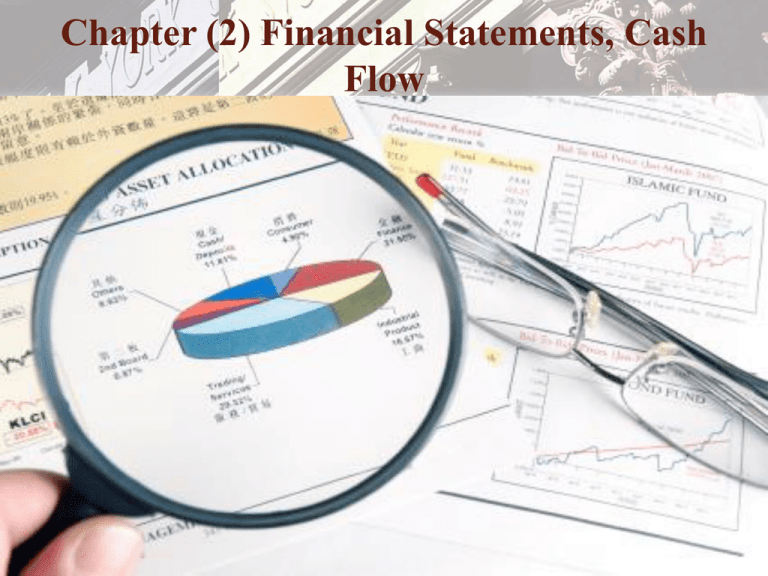
Chapter (2) Financial Statements, Cash
Flow
Copyright © 2006 Pearson Addison-Wesley. All rights reserved.
9-1
Chapter Outline:
• Overview of Financial Information.
• The Annual Report.
• The Balance sheet.
• The Income statement.
• Statement of Retained Earnings.
• Statement of cash flows.
• MVA and EVA.
Copyright © 2006 Pearson Addison-Wesley. All rights reserved.
9-2
Financial Information—Where Does It
Come From?
• Financial information is the responsibility of
management
– Created by within-firm accountants
– Creates a conflict of interest because
management wants to portray firm in a
positive light
• Published to a variety of audiences
Copyright © 2006 Pearson Addison-Wesley. All rights reserved.
9-3
Users of Financial Information
• Investors and Financial Analysts
– Financial analysts interpret information about
companies and make recommendations to investors
– Major part of analyst’s job is to make a careful
study of recent financial statements
• Vendors/Creditors
– Use financial info to determine if the firm is
expected to make good on loans
• Management
– Use financial info to pinpoint strengths and
weaknesses in operations
Copyright © 2006 Pearson Addison-Wesley. All rights reserved.
9-4
The Orientation of Financial
Analysis
• Accounting is concerned with creating financial
statements
• Finance is concerned with using the data
contained within financial statements to make
decisions
– The orientation of financial analysis is
critical.
Copyright © 2006 Pearson Addison-Wesley. All rights reserved.
9-5
The Annual Report
• It is a report issued annually by a corporation to
its stockholders. It contains basic financial
statements, as well as management’s analysis of
the past year’s operations and opinions about
the firm’s future prospects.
Copyright © 2006 Pearson Addison-Wesley. All rights reserved.
9-6
The Balance sheet
• A statement of the firm’s financial position at a
specific point in time.
Copyright © 2006 Pearson Addison-Wesley. All rights reserved.
9-7
Balance Sheet: Assets
Cash
A/R
Inventories
Total CA
Gross FA
Less: Dep.
Net FA
Total Assets
Copyright © 2006 Pearson Addison-Wesley. All rights reserved.
2002
7,282
632,160
1,287,360
1,926,802
1,202,950
263,160
939,790
2,866,592
2001
57,600
351,200
715,200
1,124,000
491,000
146,200
344,800
1,468,800
9-8
Balance sheet:
Liabilities and Equity
Accts payable
Notes payable
Accruals
Total CL
Long-term debt
Common stock
Retained earnings
Total Equity
Total L & E
Copyright © 2006 Pearson Addison-Wesley. All rights reserved.
2002
524,160
636,808
489,600
1,650,568
723,432
460,000
32,592
492,592
2,866,592
2001
145,600
200,000
136,000
481,600
323,432
460,000
203,768
663,768
1,468,800
9-9
The Income statement
• The Income statement is a statement
summarizes a firm’s revenues and expenses
over a given period of time, generally a quarter
or a year.
• Reflects performance during the period
• Income statements can cover any period of
time, but they are usually prepared monthly,
quarterly and annually
Copyright © 2006 Pearson Addison-Wesley. All rights reserved.
9-10
Income statement
Sales
COGS
Other expenses
EBITDA
Depr. & Amort.
EBIT
Interest Exp.
EBT
Taxes
Net income
Copyright © 2006 Pearson Addison-Wesley. All rights reserved.
2002
6,034,000
5,528,000
519,988
(13,988)
116,960
(130,948)
136,012
(266,960)
(106,784)
(160,176)
2001
3,432,000
2,864,000
358,672
209,328
18,900
190,428
43,828
146,600
58,640
87,960
9-11
Statement of Retained Earnings.
• It is a statement reporting how much of the
firm’s earnings were retained in the business
rather than paid out in dividends.
• A positive number in the retained earnings
account indicates only that in the past the firm
earned some income
Copyright © 2006 Pearson Addison-Wesley. All rights reserved.
9-12
Statement of Retained Earnings
(2002)
Balance of retained
earnings, 12/31/01
Add: Net income, 2002
Less: Dividends paid
$203,768
(160,176)
(11,000)
Balance of retained
earnings, 12/31/02
Copyright © 2006 Pearson Addison-Wesley. All rights reserved.
$32,592
9-13
Statement of Cash Flows:
• A statement reporting the impact of a firm’s
operating, investing, and financing activities on
cash flows over an accounting period.
Copyright © 2006 Pearson Addison-Wesley. All rights reserved.
9-14
Statement of Cash Flows
• Summarizes the changes in a company’s
cash position
• The statement separates activities into three
categories, plus a summary section:
– Operating activities
– Investment activities
– Financing activities
Copyright © 2006 Pearson Addison-Wesley. All rights reserved.
9-15
Statement of Cash Flows
• Is used to help answer questions such as:
– Is the firm generating enough cash to
purchase the additional assets required for
growth?
– Is the firm generating any extra cash that
can be used to repay debt or to invest in
new products?
• Such information is useful both for managers
and investors
Copyright © 2006 Pearson Addison-Wesley. All rights reserved.
9-16
Operating activities
• Includes:
– net income,
– depreciation,
– changes in current assets other than cash,
– Changes in current liabilities other than notes
payable,
Copyright © 2006 Pearson Addison-Wesley. All rights reserved.
9-17
Investing activities
• Includes:
– investments in fixed assets
– or sales of fixed assets
Copyright © 2006 Pearson Addison-Wesley. All rights reserved.
9-18
Financing activities
• Includes:
– Raising cash by selling short-term
investments or by issuing short-term debt
– Long term debt, or stock
– Also because both dividends paid and cash
used to buy back outstanding stock or bonds
reduce the company’s cash, such
transactions are included here
Copyright © 2006 Pearson Addison-Wesley. All rights reserved.
9-19
Business Cash Flows
• Cash Flows Rules
– The following rules can be applied to any business’s
financial statements
• Asset increase use of cash
• Asset decrease source of cash
• Liability increase source of cash
• Liability decrease use of cash
Copyright © 2006 Pearson Addison-Wesley. All rights reserved.
9-20
Sources and Uses of Cash
Sources of cash
Uses of cash
Net income + depreciation
Dividend payments
Increase in long-term debt
Decrease in long-term debt
Increase in equity
Increases in current liabilities
Cash and
cash
equivalents
Decrease in equity
Increases in fixed assets
Decreases in fixed assets
Decreases in current assets
other than cash
Copyright © 2006 Pearson Addison-Wesley. All rights reserved.
Increases in current assets
other than cash
9-21
Statement of Cash Flows (2002)
OPERATING ACTIVITIES
Net income
Add (Sources of cash):
Depreciation
Increase in A/P
Increase in accruals
Subtract (Uses of cash):
Increase in A/R
Increase in inventories
Net cash provided by ops.
Copyright © 2006 Pearson Addison-Wesley. All rights reserved.
(160,176)
116,960
378,560
353,600
(280,960)
(572,160)
(164,176)
9-22
Statement of Cash Flows (2002)
L-T INVESTING ACTIVITIES
Investment in fixed assets
(711,950)
FINANCING ACTIVITIES
Increase in notes payable
Increase in long-term debt
Payment of cash dividend
Net cash from financing
436,808
400,000
(11,000)
825,808
NET CHANGE IN CASH
(50,318)
Plus: Cash at beginning of year
Cash at end of year
Copyright © 2006 Pearson Addison-Wesley. All rights reserved.
57,600
7,282
9-23
What can you conclude about D’Leon’s financial
condition from its statement of CFs?
• Net cash from operations = -$164,176, mainly
because of negative NI.
• The firm borrowed $825,808 to meet its cash
requirements.
• Even after borrowing, the cash account fell by
$50,318.
Copyright © 2006 Pearson Addison-Wesley. All rights reserved.
9-24
Market Value Added (MVA):
• The difference between the market value of the
firm’s stock and the amount of equity capital
investors have supplied.
• MVA= Market value of stock – Equity capital
supplied by shareholders.
• MVA= (Stock Price) (Shares outstanding) Total common equity.
Copyright © 2006 Pearson Addison-Wesley. All rights reserved.
9-25
Market Value Added (MVA):
• MVA 2001:
($25*50)- (663,768)=586,232
• MVA 2002:
($20*50)- (492,592)=507,408
Copyright © 2006 Pearson Addison-Wesley. All rights reserved.
9-26
Economic Value Added (EVA):
• Value added to shareholders by management
during a given year.
• In order to generate positive EVA, a firm has to
more than just cover operating costs. It must
also provide a return to those who have
provided the firm with capital.
Copyright © 2006 Pearson Addison-Wesley. All rights reserved.
9-27
Economic Value Added (EVA):
EVA =
After-tax
Operating Income
__
After-tax
Capital costs
EVA = NOPAT – After-tax Cost of Capital
Copyright © 2006 Pearson Addison-Wesley. All rights reserved.
9-28
Economic Value Added (EVA):
• Assume the firm’s after-tax percentage cost of capital
was 10% in 2001 and 13% in 2002.
• EVA02
= NOPAT – (A-T cost of capital) (Capital)
= -$78,569 – (0.13)($1,852,832)
= -$78,569 - $240,868
= -$319,437
• EVA01
= $114,257 – (0.10)($1,187,200)
= $114,257 - $118,720
= -$4,463
Copyright © 2006 Pearson Addison-Wesley. All rights reserved.
9-29
End of Chapter 2
Copyright © 2006 Pearson Addison-Wesley. All rights reserved.
9-30








